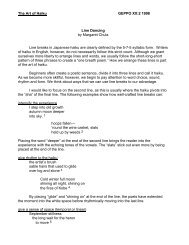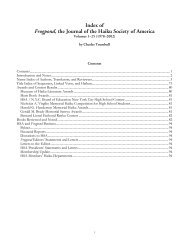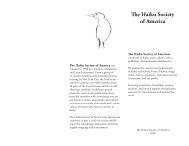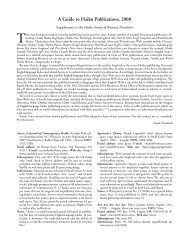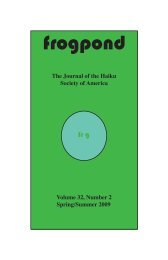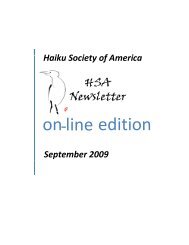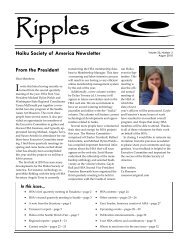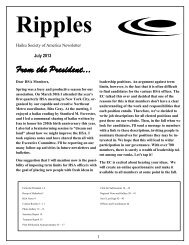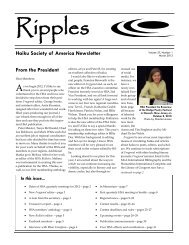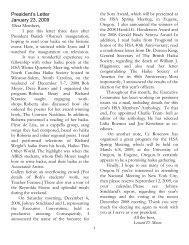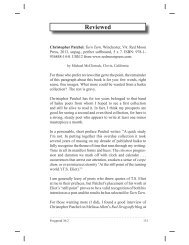Frogpond 34.3 • Autumn 2011 (pdf) - Haiku Society of America
Frogpond 34.3 • Autumn 2011 (pdf) - Haiku Society of America
Frogpond 34.3 • Autumn 2011 (pdf) - Haiku Society of America
You also want an ePaper? Increase the reach of your titles
YUMPU automatically turns print PDFs into web optimized ePapers that Google loves.
Significance & Meaning<br />
Is the writing more than a piece <strong>of</strong> description? Is the language<br />
significant, i.e., capable <strong>of</strong> suggesting more than its literal or<br />
primary meaning? Does a theme (or themes) emerge from the<br />
language choices, evoking speculation and insight?<br />
Precision <strong>of</strong> Language<br />
Is the writing concise? Does the language feel fresh? Does the<br />
writer avoid cliché and overstatement?<br />
Form, Content & Point <strong>of</strong> View<br />
Has the writing been shaped in the most effective way for its<br />
subject matter and emotional tone? Does the dramatic development<br />
feel satisfying? Is the point <strong>of</strong> view appropriate? Does<br />
the choice <strong>of</strong> tense serve the haibun effectively?<br />
Poetic Closures<br />
Does the haibun’s conclusion retain a sense <strong>of</strong> openness or<br />
“possibility” rather than a solid, definite ending that controls<br />
the reader, or prevents further contemplation?<br />
Awareness <strong>of</strong> Audience<br />
Does the haibun transcend anecdote and/or personal experience<br />
and become universal, i.e., <strong>of</strong> relevance to a wider readership,<br />
to an audience who do not know the author, or even to<br />
an audience outside <strong>of</strong> haiku circles?<br />
In spite <strong>of</strong> having the above list <strong>of</strong> criteria for selection, we<br />
did not consciously use these in our initial assessment <strong>of</strong> the<br />
haibun, just as we do not have any such list in mind during the<br />
drafting process <strong>of</strong> our own haibun.<br />
We read each one, aloud, several times, to hear the sound and<br />
flow <strong>of</strong> the piece and to get an overall view. We tried to see<br />
what was interesting; not only in the subject matter, but in the<br />
way it was expressed. We tried to be open to what could be<br />
discovered in each piece, rather than waiting for pre-conceived<br />
ideas to be rewarded. It was after this stage that we looked<br />
more particularly at each piece, and selected the criteria that<br />
we felt were most relevant to the haibun under discussion.<br />
. . . . . . . . . . . . . . . . . . . . . . . . . . . . . . . . . . . . . . . . . . . . . . . . . . . . . . . . . . . .<br />
<strong>Frogpond</strong> 34:3 109



